#Shibuya Aoi
Explore tagged Tumblr posts
Text
Happy Anniversary to Digimon Survive

I had something else planned for today but I left my tablet at home and will be away for a while. So I had to borrow my little sisters tablet again for this one.
#digimon survive#digimon#Digimon survive 2nd anniversary#momozuka takuma#hinata minoru#shibuya aoi#kayama shuuji#kimishima saki#tominaga ryo#shinonome kaito#shinonome miu#agumon#koromon#falcomon#pinamon#labramon#xiaomon#lopmon#chocomon#floramon#yokomon#kunemon#tokomon#dracmon#tsumemon#syakomon#Shakomon#bukamon#The way I rushed to draw for this anniversary instead of a certain popular game anniversary#(I'm sorry I love you too but this is where my heart lies)
219 notes
·
View notes
Text
Kaito, Aoi, and the Importance of Digimon Survive's Intertexuality Across Routes
Digimon Survive is such a powerful narrative because its core theme is reinforced through its very structure as a visual novel. The game's radical belief in the ability for anyone to blossom into the best versions of themselves given the right circumstances is a powerful concept, but it could easily come off as naive. To avoid coming off as naive, there must be an acknowledgement of the darkest parts of our hearts.
It's like this:
In the Truthful Ending, Kaito has some issues with anger and overprotectiveness, but ultimately develops a slightly healthier relationship with his sister. A fine snapshot of a young boy's life over the course of a few weeks, but is it a snapshot of the young boy's soul? I think not. That snapshot comes in more parts. To see how his relationship with Miu would develop in more dire circumstances, you must see Moral Route. To see how he would cultivate a more strenuous relationship with Miu in light of a heightened sense of danger in the world, you must see Wrathful Route. To see who Kaito would become without Miu's grounding presence, you must see Harmony Route.
By seeing Kaito across four dimensions, you are able to form a picture of the actual Kaito. In composite, Kaito is obviously a good person. He is motivated by a desire to protect. He is brave. He cares for people. Even his friends who he betrayed in Harmony Route could see that deep down, Kaito had the potential to be a good person. This is seen when they all wish to extend an offer of forgiveness to Kaito, even after he resolved to destroy the world. By seeing Kaito at his absolute worst, we actually see a glimmer of his potential.
(I would like to clarify that I do not believe that Kaito "redeemed himself by dying," nor is it my reading of the text that Kaito was made to die as punishment for his misdeeds. I understand how one may come to those readings of the text, but I believe it was an unfortunate and unintended implication at worst.)
Aoi is an overachiever. She's a bright young girl, and that comes with certain expectations. If one were to look at her on a very surface level, you would think that she understands the importance of the responsibilities she's been given, and she doesn't mind the extra work. That is obviously bullshit, but to some extent, this is the image she puts out into the world. Aoi is not forthcoming about her emotions, so prior to meeting Labramon, she allows herself to stoically accept an unfair burden. Her fellow students take advantage of her, and her opinion is rarely respected among the other chosen children when discussing next steps. Without the ability to assert herself, she has all of the responsibility with none of the actual power. She must work hard, but she cannot do good.
This is a shame. Aoi is motivated by a strong sense of justice. The best version of herself is one who has the confidence to set boundaries and stand firm on issues she cares about, but much like Kaito, watching her grow into her best self is merely a snapshot of a few weeks in the life of a child. To truly plunder the depths of Aoi's soul, we must look into Wrathful Route.
In Wrathful Route, we see the most explosive expression of Aoi's convictions. She learns that a sense of justice is worth nothing if you don't have power, and power is worthless if it is not used. While nobody younger than Aoi dies in Moral Route, and Miu's safety in Harmony Route is Kaito's responsibility first and foremost, Saki's safety was squarely Aoi's responsibility.
Aoi's grief over her own failure to uphold her values causes an overcorrection. She is overcome with a desire to wield the maximum possible power and realize a twisted vision of maximum possible justice.
I love the gusto, Aoi, but human instrumentality is not a healthy response to traumatic invalidation.
It's important to stress that while I love Saki and think Saki/Aoi is an adorable ship, Saki's death is not the sole cause of Aoi's mental anguish. Saki's death was the catalyst for Aoi to close herself off from the community who could have helped her. The anguish began developing years prior.
In other routes, Aoi's relationship to her sense of justice, her responsibility, and her assertiveness develop in different ways, but by examining Aoi across four dimensions, we can understand Aoi's actual self. In composite, Aoi is a good person. She has strong convictions. She is protective. She is capable. There are a lot of ways these values can shape a young girl, and Aoi deserves a life where she has a supportive community to allow her to grow into the best version of herself. Don't we all?
At the core of both Kaito and Aoi, we find good people. I like to think you'd find the same at the core of everyone in real life, too. And yet, in real life, we obviously find people who do work to make the world a worse place. In Digimon Survive, we can see the paths not taken, for better and for worse. In doing so, we see the Truth of each character.
(This is not wholly unrelated to the appeal of "the Digimon as a reflection of the human partner's true self." In Dracmon, we see Kaito's protectiveness in a more trusting and easygoing package. In Labramon, we see Aoi's supportiveness in a more assertive package.)
#digimon survive#digimon survive meta#aoi shibuya#shibuya aoi#digimon survive week#but late#day 2 cooperation#very late okay?#hi maq
49 notes
·
View notes
Text
"Becoming as One" and the Themes of Harmony in Digimon Survive
Overanalyzing Aoi and Shuuji again, because this is my new hobby ever since I played Survive.
They share many parallels, both obvious and subtle, that I feel are often overlooked. One of the lesser-discussed similarities is how their corruption arcs culminate in “bio-merging” with their respective partnermon, a process where the human and partnermon become a single entity. Since both characters are Harmony-aligned, I believe it’s worth exploring how these instances of bio-merging relate to and represent the themes of Harmony. More under the cut.
TWs: discussions of self-loathing and suicidal thoughts
Given that the partnermons are meant to reflect their human partner’s true self, I find it somewhat ironic that in two out of the three instances of bio-merging in Survive, the result paradoxically embodies a loss of self. While it makes sense when you consider the Harmony kids’ common thread of seeking conformity, one might expect that merging with one’s true self would lead to the realization of true selfhood. Instead, these unifications become vehicles of self-erasure, where the former self is submerged by a new identity, as they are represented as dark evolutions that occur when the ideals of Harmony are taken to an extreme.
To get what I mean, let’s consider Kaito’s corruption arc. Symbolically, Kaito letting go of Dracumon by fusing Vamdemon (Dracumon) with Piemon can be seen as him discarding his conscience to further his selfish desires without any regard for others. This makes sense to most of us easily, because we’re consistently shown how Dracumon acts as Kaito’s restraint throughout the story — his “moral compass”, if you will. Without Dracumon, there’s no one who can keep Kaito in check anymore. So, the “death” of Dracumon being the metaphor for Kaito going morally bankrupt feels pretty intuitive, at least to me personally.
In contrast, I didn't find the symbolism in Shuuji’s and Aoi’s corruption arcs—particularly their fusion with their partners—as immediately intuitive, for the reasons I’ve outlined earlier. However, after mulling over their arcs a bit more, I’ve come to the realization how both of them becoming one with their respective partner can actually carry multifaceted symbolism that may not be immediately apparent. Also, the different nuances in how the themes of Harmony manifest in their arcs mean that the symbolism works a bit differently in each of their arcs too. Let me explain.
First off, we’ll look at Shuuji and Lopmon. Shuuji’s arc revolves around his struggle with self-acceptance. Through his father’s relentless expectations, he’s always made to feel inadequate, and in turn it drives him to constantly force himself into an imaginary mold that he doesn’t fit into. He does this by repressing his true feelings while trying to live up to (what he believes to be) his father’s idea of a perfect self. His very apparent hatred of Lopmon is mostly meant to represent his self-loathing, among many other things — in a way, Lopmon serves as a reminder for Shuuji that he hasn’t truly changed into the person that his father wants him to be. This is why Shuuji keeps trying to force Lopmon to change as well, even if it means cruelly pushing him beyond his limits.
The outcome of Shuuji’s arc depends on whether he comes to recognize his mistaken beliefs. If he fails to do so, Lopmon evolves into Wendimon and devours him. As this post has already described, this scene serves as a metaphor for Shuuji succumbing to the self-hatred that has been eating away at him from within, leading to a complete loss of self. Because, in both a figurative and literal sense, no trace of Shuuji’s former, “true” self remains—just as there’s nothing left of the Lopmon we once knew in Wendimon.
Most people believe that this is the moment where Shuuji finally dies, but I think that isn’t the case. In Survive, the lore states that a partnermon dies the moment their human dies. However, Wendimon doesn’t die right after he completely consumes Shuuji, and instead, he gains the ability to speak. Make of this what you will, but in my opinion, this gives a clue that Wendimon being alive after consuming Shuuji isn’t merely a narrative convenience to keep him around for the fight, and that Shuuji has actually been absorbed into Wendimon. In other words, Shuuji and Lopmon are finally unified in their suffering as Wendimon, with Wendimon’s monstrous form serving as a visual manifestation of both Shuuji and Lopmon’s new identity, warped beyond recognition even to themselves.
If you pay close attention to Wendimon’s speech, you’ll notice that he actually speaks with two voices — both Shuuji’s and Lopmon’s. It can be hard to tell since the voices are heavily filtered, but Shuuji’s voice has a slightly deeper pitch than Lopmon. Even if you can’t tell, the story hints at this detail by showing how the other kids and partnermons can distinguish between the voices when Wendimon speaks.


“IT HURRRTS… I’M SCAAARED… I DON’T WANNA DO THIIIS…” “WHAT’S… WRONG WITH ME? WHAT SHOULD I HAVE DONE…?”
I bring this up because it’s intriguing how Wendimon speaks in dual voices despite supposedly being a single entity. It’s as if the story is trying to convey that, even in their merged state, Shuuji and Lopmon aren’t truly reconciled — and it’s because Shuuji hasn’t silenced the part of himself that continues to question and doubt. To understand this, notice how Wendimon wails about two entirely different things: in Lopmon’s voice, he cries about how he doesn’t want to do any of this anymore, how he’s scared of this and how it hurts. Meanwhile, in Shuuji’s voice, he rants about not knowing what he should have done to make others happy (but especially to please his father, as I believe his words are primarily directed at his father) and wonders if it’s better for him to disappear if his existence is a nuisance to other people. While Lopmon continuously voices Shuuji’s true feelings that he buries deep inside, Shuuji himself remains fixated on seeking external validation and is concerned about what others think of him even at the expense of his own well-being.
To understand why Wendimon having dual voices is relevant to this discussion in the first place, let’s now turn our attention to Aoi and Labramon. Aoi’s character arc revolves around her desire for authority and proactiveness, which she struggles with because her self-consciousness constantly holds her back from taking actions. This is largely why Aoi and Labramon’s dynamic is vastly different from Shuuji and Lopmon’s relationship, because while Aoi also represses the side of her that Labramon displays — whether subconsciously or not — Labramon’s outspokenness instead embodies the part of Aoi that she wishes she could express more freely but is suppressed by her insecurity.
When Aoi merges with Labramon, the situation is slightly different from Shuuji’s experience, though it carries its own tragic implications: in an effort to save Aoi, Labramon sacrifices her own “self” to become the new force that sustains Aoi’s life. Perhaps because it’s also fueled by Aoi’s overwhelming guilt and frustration over her perceived powerlessness, the act leads them to bio-merge and dark-evolve into Plutomon.

While not entirely analogous, I think it’s fair to make a comparison between Plutomon and Wendimon. The game itself does this as well: upon seeing Aoi becomes Plutomon and kills Piemon, Kaito instantly makes a remark of Aoi becoming like Shuuji. In English, the line is worded as:
“Don’t tell me this is like with Shuuji… When he turned all evil!?”
However, in Japanese, the line is:
“まさか……シュウジのように……暗黒進化か!?” “Don’t tell me… she’s become like Shuuji… is it a dark evolution!?”
It’s interesting to me that Kaito immediately draws a parallel between her and Shuuji. And I have to emphasize that it’s specifically Shuuji, not Lopmon. I’m saying this because they all perceive Plutomon as Aoi instead of Labramon (the game emphasizes this too by having Plutomon’s name initially written as “Aoi?”), whereas we (as the players) tend to perceive Wendimon as Lopmon instead of Shuuji. See where I’m getting at here?

“Aoi, you say? No, I’ve cast off that weak persona.”
Now, unlike Wendimon, who retains both Shuuji’s and Lopmon’s voices, Plutomon speaks only with Aoi’s voice. One interpretation that we can draw is that, unlike Wendimon, the singular voice might represent Aoi and Labramon reaching a true level of mutual understanding and harmony where they don’t have to speak over each other in order to be heard. But I think there’s more to it: given that Labramon is consistently depicted in the story as voicing Aoi’s inner thoughts that she keeps holding back from expressing, I think this is meant to also symbolize her internal resolution where she no longer has the need to externalize her inner thoughts through Labramon, as she now fully embodies those thoughts herself. This might seem empowering at first, seeing how her newfound confidence seems to have conquered her lingering self-doubt that used to haunt her. However, on the other hand, the loss of Labramon’s separate voice means that Aoi has lost an external perspective. The implication is that Aoi is now entirely self-reliant, with no external check on her thoughts or actions. In other words, Aoi has lost the ability to see herself from an outside perspective that used to keep her grounded and connected to the world outside herself.

“Labramon agrees, from deep down inside me.”
(I put the screenshot above because I find it interesting — I think the fact that Aoi speaks on behalf of Labramon, rather than letting Labramon speak for herself, further supports the interpretation of Aoi having absorbed Labramon’s voice into her own, leaving no room for external input anymore.)
This ultimately leads Aoi to form a singular belief system, one that’s entirely shaped by her internal convictions. And it drives her into a dangerously inflexible mindset where any form of disagreement or differing perspective is perceived as a threat to her newly discovered harmony. In her mind now, the only way to ensure peace and unity is to eliminate the possibility of conflict altogether by merging everyone with their partnermon, creating a single, unified consciousness. And Aoi is absolutely resolute in this, because she has now isolated herself in her certainty by silencing other voices, becoming rigid and intolerant of any challenge to her worldview — one rooted in a distorted sense of harmony that results in a situation where disagreement is eradicated, not resolved.
Some of you might find it ironic that, despite supposedly embodying the corruption of harmony, Aoi (as Plutomon) seems to act more on her own selfish ideals rather than striving for true consensus, even if flawed. However, this makes sense when you contrast her motivation with Shuuji’s: while Shuuji is driven by external pressures and doesn’t necessarily “enjoy” conforming to others’ expectations, Aoi’s actions stem purely from her own self-imposed ideals. Aoi genuinely values social propriety and seeks to uphold it (as @digisurvive puts it, she’s the reason why the group is very hierarchical — she always makes sure that everyone follows the rules of conduct properly), so it’s natural that the themes of Harmony would manifest this way in her corruption arc. So, while Shuuji being absorbed into Wendimon through devouring represents the ultimate death of self, Aoi’s bio-merging with Labramon into Plutomon instead gives her an epiphany of her ideal version of “Harmony”—one she feels compelled to enforce on everyone.
#digimon survive#shibuya aoi#kayama shuuji#plutomon#wendimon#labramon#lopmon#digimon survive spoilers
13 notes
·
View notes
Text



so tokyo mew mew ole anime when
#im sure all the boys would have top tier seiyuus#tokyo mew mew#tokyo mew mew ole#tokyo mew mew ore#tokyo mew mew au lait#why does it have so many names CHOOSE ONE#momomiya ichigo#shibuya aoi#i hated the final sm tho#shibuya is a full red flag if you read it closely#i still like him tho#fanart
12 notes
·
View notes
Note
Do your boy Shuuji with 11, 16, 20 and 29 (I still owe u that last one lol)

What’s the first thing you think about when thinking about the character? It's mostly the same as your answer to this question wrt his story being a really nuanced depiction of parental abuse in fiction, though I also think a lot about how he's the perfect partner for Lopmon writing-wise. I don't think the potentials present in Lopmon's themes of duality have ever been quite as realized in the franchise before he got paired with Shuuji, so yeah... (what I'm trying to say is that his characterization just seems very fine-tuned to Lopmon's lore and I love it)
A childhood headcanon Rich kid Shuuji hc is very strong, so the biggest one is that his parents signed him up for a bunch of high class extracurricular activities mostly for the academic aspirations they had for him. He hated them at first, but eventually he learned to suck it up and just go through the motions, because rebelling resulted in getting berated.
A weird headcanon Uh... not weird probably, but perhaps the most random headcanon I can come up of him is that he can't stand the taste of coffee. He needs it to stay up late for studying though, so he's the type to add too much milk or sugar to his coffee to offset the bitterness.
What do you think is a secret they have that they never told anyone? This is hard... he used to keep a lot of secrets, but he already seems much more laidback and less insecure in Truthful alone? He even readily opened up about his darker thoughts like how much he hated himself or the guilt that haunted him... maybe, while it's freeing for him to stop thinking of what his father wants him to be, deep down he feels more clueless and directionless than when he was still obsessed with following his father's wishes, because he's gotten so used to chasing after the ideals set for him by his father that he kind of forgets how to "want" for himself or have a passion of his own. On top of that, he feels like he's never sure if he makes the right decision with his choices. So TL;DR even though it's stressful, in a way it's easier for him to follow a path someone else has laid out for him than to be "selfish" and do some soul-searching for himself. It's a bitter reality he's never ready to admit because it makes him feel like admitting a defeat right after earning his victory.
(As for Aoi: considering how rigid she can be with her views, I think she's much more judgmental as a person deep down inside than she's willing to admit. She knows how unlikeable that trait is though, so she tries to conceal it, however sometimes it surfaces via her projecting herself on other people)
How do you think they would be as a parent? (and if they are a parent, how do you think they would be if they weren't?) YOU'VE SAID EVERYTHING I WANTED TO SAY ABOUT THIS LOL especially how he'd be especially self-conscious about not wanting to become like his father + being emotionally awkward/distant without meaning to. An extra one is perhaps when he inevitably fights with his child, he'd sometimes slip back into his old behavior and regret it afterwards. Having grown up in a family where he had no chance to air out his problems with them and fight for real, he'd always feel awkward about having to make up with his child, so he'd send Lopmon first to console his child after things calm down before talking to them himself.
23 notes
·
View notes
Text
The nail that sticks out gets hammered down
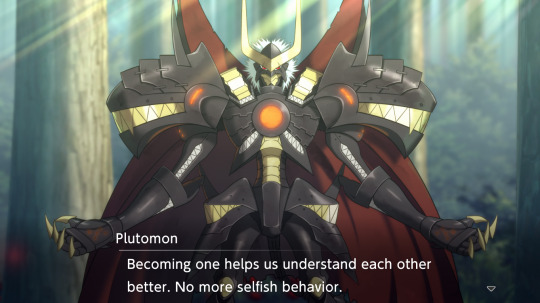
[Image Id: Screenshot of Plutomon’s sprite with its arm open and looking to the front over a forest backdrop. Her dialogue reads: Becoming one helps us understand each other better. No more selfish behavior]
Or Extreme Collectivism as horror.
It’s plain to see that Plutomon’s posture is one that threatens to crush any and all dissent, no matter how small, as well as to erase individuality— with that of its ultimate goal being to merge the enterity of the two worlds together with her, so they can all share her (correct) feelings and values. This is all with the aims to eradicate any selfish behavior, which in short can be any attitude or ideology that disrupts a group. This conduct being horrific is quite obvious, but it's also quite thematically rich coming after everything in the vanilla pre-timeline split.
If Plutomon is someone who values social harmony above all, Ryo existed on the opposite end of the scale: with an unhelpful, uncooperative attitude that went beyond not helping the group—the events leading up to his death are caused by his own imprudent actions, straight up risking everyone when he took off on his own. His bad attitude makes him hard to deal with, and the rest of the group often lets on their exasperation with his doomerism and inaction. Takuma is always tempted with the choice to give up on him and leave him alone.
This attitude is echoed with how the group deals with Shuuji, too; the others often show their (warranted) frustration with his insufferable behavior. Survive’s writing often seems to egg the player to agree with the idea that leaving both Ryo and Shuuji behind would ultimately be for the greater good. It insidiously seems to present the player the idea that isolating troublesome, struggling individuals, the problem children of the group, is for the best. This is an attitude that echoes the status quo of how society deals with individuals suffering with mental health harships: by shunning them out and judging them incorregible. The fact that the option to leave the black sheep behind feels reasonable is no coincidence, and it's the reason the game ends up guilt-tripping the player hardcore over the fact Ryo and Shuuji were never fully integrated into the group.
The fact Aoi ends up going off the deep end of the attitude that prevented Ryo and Shuuji from getting help in the first place, kickstarting the whole tragedy, is one of the nuances that add more value to Plutomon’s absolutism. She views any disruptions to the Harmony of a group as the worst offense anyone can take, and sets out to prevent others from being wrong in the first place. It’s a very Japanese viewpoint: hating to burden others with one’s personal problems and hating the disruption of the communal harmony.
The horror behind Plutomon is an unyielnding, cold perspective over how a group should operate: a social dynamic where you don’t trouble others with your personal failures and problems. Where questioning authority is harshly punished. Where there's no room for anyone's input but the one on top's when it comes to decision making. Where any expression of internal struggle is repressed due being incompliant, uncooperative and selfish. And they can indeed be selfish and disruptive to the workflow of a group, but that’s not necessarily evil or warranting ostratizing. They’re, in fact, symptoms of a deep hurt that needs to be healed in order for a group to operate better.
It's inevitable for individuals to inconvenience a group with their needs, but sharing the burden is the ideal the game presents as an answer to be able to fulfill both the greater good and individual care. Survive proclaims not just that struggling indivuduals deserve care and support but that it’s a communal duty to provide it and a moral failure not to do it.
#Digimon Survive#Digimon Survive spoilers#Aoi Shibuya#Shibuya Aoi#Plutomon#Wrathful route#pretty much just sying how nicely the horror of Plutomons extremism plays off the attitude that isolated the problem children earlier#i got another plutomon adjacent post in the works lol i love aoi sm lol#aoi#meta#mine
68 notes
·
View notes
Text
Winds of Change
Chapter 5: Something in the Air
Shuuji knows something is amiss when he catches Syakomon let out an almost imperceptible sigh of relief. He’s lucky that the viscous surface of Syakomon’s slimy green body betrays her—the quiver of the otherwise silent exhale sends a faint, wobbly shockwave across her skin, and she jiggles ever so slightly in her shell, as though somebody’s just set down a cautious bowl of lime-flavored jello.
Supposedly, the worst is over, but Shuuji can't shake the feeling that there's something the Kemonogami aren't telling him.
ao3 link in source , extended end-of-chapter author's notes under the cut!
oh BOY the editing situation was a doozy. granted, i was also busy with work, but even then this chapter needed a TON of reworking, much much more than chapter 4 did. like i said on ao3, it got to the point where this chapter was so long that i had to split it in two.
i also mentioned that this chapter marks the beginning of the second half of this fic. chapters 1-4 make up part one, which i'd summarize as "how did we get here?", and then from 5-8, the focus will be "what happens next?". it helped a LOT to recontextualize chapters 5-7 (now 5-8) as an answer to chapters 1-4, and i think it'll make editing easier going forward; i have much more direction now and a better idea of what needs to be expanded on and what needs to be cut.
unfortunately, like i said, i had to omit a lot of saki-centric stuff. she is the scariest character for me to write, and i think i need to progress more thru my replay of truthful before i feel confident enough to write from her perspective. it works out anyway, because the part i cut had shuuji taking a very passive role and just observing interactions between saki and floramon, and it felt very drawn-out and unnecessary. this is my favorite cut segment tho
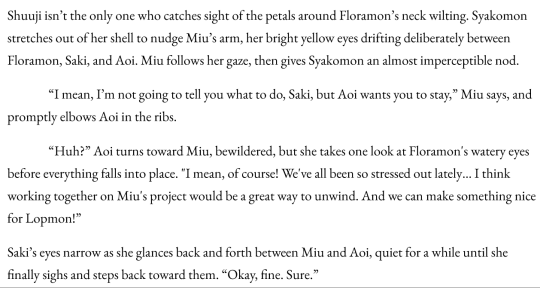
im really hoping to be able to figure out what an aoi-miu-saki dynamic looks like as i get more comfortable writing the three of them. i think it could be really fun. also i think it would be so funny if miu and saki bring out a mischievous side of aoi that would otherwise not exist. much to think about.
anyway. another challenge i had with editing this chapter was the topography of the beach area the group hangs out at before moving on to the shopping district and apartment complex. for some reason i was convinced the rocky beach area was like.. up on a cliffside? but then i looked at the map and got REAL confused. the beach is super super narrow, and that was really inconvenient when i needed shuuji to be somewhere relatively out of the way, where he could have a conversation with agumon that takuma cannot hear, while still being able to see takuma. so thats why i spent an hour and change squinting at the tiniest png of the map and reorganizing where people spend their time

if my handwriting is illegible (from left to right) (oh my god now that ive added the image to the post its a nightmare. idk why im even posting it. lord. im not sure opening it in a new tab will help) factory residential area shopping district woods near shopping district minoru up here group rests here waterway exit from shaft here instead; rest of waterway rock w/ supplies hill down from the waterway shuuji rests here pt 6 argument happens here aoi & ryo here in ch4 (this is where they were keeping watch) miyuki here
i didnt make many changes; mostly i just moved people around. the one thing that i DID change though was the placement of the waterway entrance. i have NO IDEA why the game has it in the middle of the fucking ocean. like i know theres a tunnel there, but surely the entrance to that tunnel isn't underwater right? i then poured another hour and change learning about waterways, trying to figure out where it made the most sense to put the exit before remembering that it doesn't matter because the digital world doesn't play by human world rules. oops! it was still super interesting though! please look up 'tokyo g-cans' if you ever get the chance, its fucking fascinating. if i ever go back to japan id like to go down there, maybe.
obligatory commentary about the map:
oh my god it seems too big for what we actually see but im not a cartographer so i dont know for sure
the shopping district/apartment complex is visible from the beach but i feel like it shouldn't be: on the map it looks like it's on a cliff face while from the beach it looks like it's shore level
i've been reading half the green patches as dense tree cover but now that i think about it, that might just be open grassland. oops. it's all trees now.
i wish we could go to the sandy beach areas to the north and east ends of the island!!! that could've been fun!
i really appreciate that the second island is shaped vaguely like a beluga
in other news, agumon was much easier to write than i was worried he would be, and it was nice to work out how he felt about what happened in the waterway. one thing ive noticed about agumon on a second truthful run is that he and takuma are equally awful about pushing down their own feelings for the sake of the ones of their friends. a lot of the others seem to view agumon as the guy who is always Staying Silly , no thoughts head empty. while i DO think that that's a genuine part of his personality, i think it also happens sometimes that he uses that image to downplay his concerns.
my favorite part to write this chapter was labramon's dialogue at the end. and also baby stats. baby stats was the ONE THING i REFUSED to cut. non-negotiable. it's been in my notes since the beginning and digimon survived all edits of this chapter, and i was DETERMINED to keep it.
all right im getting sleepy and i want to post this chapter and then go to bed. as usual please dont be afraid to leave a comment, i looooove finding out people's favorite parts, and im still curious about your Gamer Theories, especially now that i think what i'm foreshadowing is becoming clearer and clearer >:3c
couldn't tell you for sure when ch6 will be out. ideally it won't involve as much editing as ch5, but it's hard to say. thank you for reading, and i'll be back as soon as i can!
#digimon survive#shuuji kayama#kayama shuuji#ryo tominaga#tominaga ryo#agumon#aoi shibuya#shibuya aoi#im so sorry @ ppl who are in the aoi shibuya tag for the other aoi shibuya (the one who is not a digimon character)#labramon#miu shinonome#shinonome miu#syakomon#floramon#digimon
7 notes
·
View notes
Photo

✧・゚:*Today’s magical boy of the afternoon is: Shibuya Aoi from Tokyo Mew Mew Au Lait!✧・゚:*
#Shibuya Aoi#Tokyo Mew Mew Au Lait#manga#black hair#animal ears#magical boy#magical boy of the day#mahou shounen
40 notes
·
View notes
Text
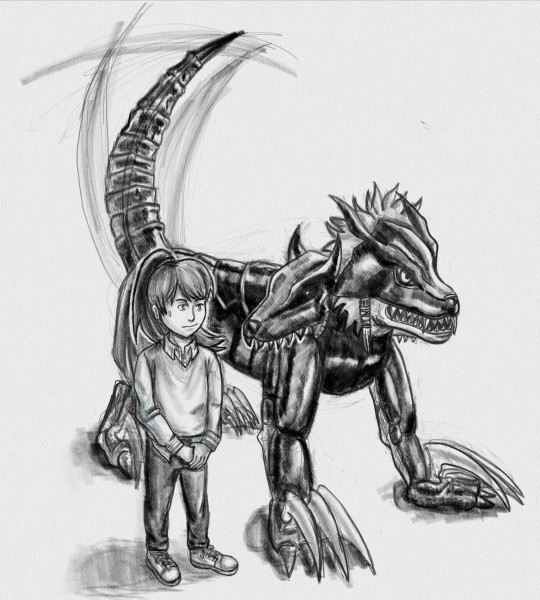
Just a girl and the hellhound reflection of her heart
#Digimon#Digimon Survive#Aoi Shibuya#Shibuya Aoi#Cerberumon#Digisafe#The rendering for this one is rougher but it gives it charm imo#Totally doesn't want to rip you to shreds 😊#Description in alt text
44 notes
·
View notes
Text
Digimon Survive Week 2024
Day 1: A New World
“Aoi? What’s wrong?” She wishes he didn’t ask. She wants to be cheerful and kind. She really does.
Dusted off this old thing for today's prompt. I have a lot of mini fics with conversations between Aoi and Shuuji or Kaito and Shuuji or Aoi and Kaito for some reason (oops gotta be the faves).
Also, it mentions a bit of my JIES headcannon that I wrote for one of last year's prompts.
@surviveweek
12 notes
·
View notes
Text
Aoi Shibuya 🥰
[writes emotional essay about Aoi's character arc and how deeply it touched me, and then deletes it]
7 notes
·
View notes
Text
Aoi and Shuuji : Gendered Subtexts in Their Partners' Evolution Forms and How They Parallel Each Other
Believe it or not, this started out as me about to go on a long rant about the discourse on that Wukong game, since I feel like both sides are presenting their arguments in disingenuous manner regarding queer and feminist readings of Journey to the West (which involve discussions of Wukong and Guanyin as representations of feminist ideals and queer identities). However, I decided I wasn’t that invested in the discourse to write long paragraphs about it, so instead I chose to channel my energy to discuss something else you might not expect to have anything to do with this… which is Digimon Survive (lol). This writeup is going to discuss about Shuuji and Lopmon again, anyway (lol) — and yes, it’s going to be discussing about gender as well, and I’ll be doing it by drawing parallels with another pair, Aoi and Labramon.
A disclaimer before we start: as I’ll be discussing about the various interpretations of Guanyin (that, I feel, some might find sensitive — as they relate to Guanyin’s gender identity), I’d like to make it clear that I’m not a Buddhist nor was I raised a Buddhist by my family. However, I grew up in a culturally Chinese family, and have close relatives who are Buddhists that I’ve consulted on the depictions of Guanyin for the purpose of this writeup. I’ve also done extensive research about the figure online using various resources in English, Chinese, and Japanese. Take this information as you may (this also applies to other deities/figures I talk about in this writeup too, anyway). Heed this disclaimer here as well.
Another note: This writeup wasn’t as well-planned as my previous ones, so I apologize if it seems like I’m jumping from one point to another. It’s mostly me thinking out loud about more parallels I’ve discovered and the ideas I have about them. Just a heads up.
Some people have pointed out the parallels between Aoi and Shuuji, particularly in how their character arcs explore gendered themes. Both characters initially put on a facade that aligns with societal expectations of their gender roles, and each is paired with a Digimon/Kemonogami partner that jarringly contrasts with their outward persona — which makes sense, since the partnermons reflect the true self they both try to suppress. This post, in particular, also elaborates a bit further on the parallels by discussing about how their character arcs move in opposite directions. To reiterate: Aoi begins as the nurturing and permissive mother figure of the group, almost stereotypically feminine, but as the story progresses, she steps into a leadership role and embraces a more assertive personality, which isn’t necessarily associated with traditional femininity. Conversely, Shuuji starts off trying to fit into the rigid mold of an authoritative leader, believing this is what’s expected of him as the oldest boy in the group. However, he eventually must embrace his gentle and caring side to enable himself to reach his full potential, which challenges the initial idea presented that masculinity must always equate to emotional stoicism. Basically, by the story’s end (at least in the Truthful route), both characters take on roles more commonly associated with the opposite gender.
You might think the gendered themes of their character arcs end just there, but if you look into the evolutions of Labramon and Lopmon, you’ll uncover even more layers of gendered subtext — undertones that, while likely unintended, are intriguing to explore. It’s something that seems to have gone largely unnoticed, so that’s exactly what I’ll write about now. Hopefully this can offer another interesting perspective to their character arcs.
Let’s start with Labramon, as the subtexts in her evolutions feel less subtle to me. From the game mechanics alone, initially, Labramon functions primarily as a support unit, equipped with a healing skill that aligns with stereotypical feminine roles of care and nurturing. However, as she evolves, I’d say this role shifts rather significantly. In her evolution forms (Dobermon, Cerberumon, Anubimon, and even Plutomon), Labramon transitions into a powerful offensive unit, taking on a more aggressive and assertive role that contrasts with her earlier, more traditionally feminine characterization.
What’s also particularly striking is the design and appearance of these evolutions. Dobermon, Cerberumon, and Plutomon all adopt distinctly masculine aesthetics, characterized by strong, fierce, and intimidating designs that align with traditional male archetypes. They also shed the cutesy appearance that Labramon initially has, replacing it with a color palette dominated by black and deep shadowy tones on top of very sharp silhouettes, which starkly contrast with Labramon’s original softer look. It almost feels as though her evolutions discard femininity to embrace more conventionally masculine traits like strength, aggression, and dominance. The game even alludes to this by showing how taken aback Aoi is when she first sees Cerberumon’s intimidating appearance.
Not only that, both Labramon’s two ultimate forms, Anubimon and Plutomon, are based on male deities. Anubis, the god of afterlife in ancient Egyptian religion, is strictly male in his depiction as a man with a jackal head. Even the etymology of his name reinforces this — the name “Anubis” comes from the ancient Egyptian word “Inpw”, which is masculine in grammatical gender. In ancient Egyptian language, words had gender, and the suffix “-w” typically indicated a masculine form (hypothetically speaking, the female form of “Inpw” would have been “Inpwt”). Additionally, Anubis has always been depicted with male attributes and roles in Egyptian mythology, such as being a protector of tombs, which was customarily a male-associated role in ancient Egypt.
Pluto is also consistently depicted as male in the original Greek mythology. The name “Pluto” (Plūtō) itself is the Latinized version of the Greek “Plouton”, which is a euphemism for the underworld god Hades, who is also strictly male. What’s even more interesting to note is that Pluto is the Roman counterpart of Dis Pater (Rex Infernus), whose name is commonly interpreted as “Rich Father” and may be a direct translation of Plouton. Note how the meaning of the name emphasizes the male aspect of the deity, as the title “father” is already inherently masculine.
Despite all of that, though, one thing I want to also note here is that Labramon and her evolutions consistently maintain a feminine speech pattern that’s largely shared by Aoi. An explanation for context: in Japanese, you generally can tell the gender identity of the speaker from their speech pattern (i.e., the way a male individual speaks and a female individual speaks are pretty distinct). I find this especially interesting, because it shows that you’re meant to take Labramon and her evolutions as female despite the traditionally “male” depictions.
(Sure, you might argue that this is just another instance of Digimon taking liberties with gender depiction, as they did with Garudamon in Adventure. However, I still find it intriguing to note that among the female cast, Aoi is the only character whose partner’s evolutions are consistently gendered as “male” within the Digimon franchise.)
Let’s move on to Lopmon and his evolutions. While Lopmon doesn’t undergo the same dramatic shifts in appearance the way Labramon does, he does give off a somewhat feminine vibe with how cute and very “pink” (for the lack of a better word) he looks. This has led to some mistaking Lopmon as female, even though his speech pattern closely resembles Shuuji’s distinctly male speech pattern (this is a similar case to Aoi and Labramon anyway, where they share similar speech patterns with each other). Aside from that, there is also still a gendered theming present in his evolutions. In particular, two of his evolutions, Turuiemon and Andiramon, feature genderqueer elements in their origins.
As I mentioned in my previous writeup, Turuiemon is based on Tu’er Ye (Tù’eryé/兔兒爺), the rabbit deity entrusted with saving the people from a plague. According to the legend, Tu’er Ye needed to borrow clothes to wear in order to gain the trust of the people. What I didn’t mention, however, is that Tu’er Ye also had a female counterpart called Tu’er Nainai (Tù’ernǎinai/兔兒奶奶). While these two figures might seem distinct, they could actually be one and the same deity. In some versions of the legend, Tu’er Ye changed appearance depending on the clothing donated to him by the people he helped, implying that Tu’er Nainai could simply be a cross-dressing Tu’er Ye. In short, Tu’er Ye can be interpreted as genderqueer due to the fluidity of his gender presentation in these legends.
The genderqueer theme becomes even more prominent in Antila, the figure upon which Andiramon is based. Antila (Āndǐluò/安底羅) is one of the Twelve Heavenly Generals serving Bhaisajyaguru (the Medicine Buddha). Although Antila is strictly depicted as male and isn’t necessarily genderqueer in the original legend, he takes on a genderqueer interpretation through his depiction in Japanese religious syncretism of Buddhism and Shinto (shinbutsu/kamihotoke/神仏): Through a concept known as honji-suijaku (本地垂迹), where Buddhas and bodhisattvas serve as the true forms (honji/本地) that have worldly manifestations (suijaku/垂迹) as Shinto kami (神), it is said that Antila was the worldly manifestation of the bodhisattva Guanyin (i.e., Guanyin is the honji of Antila, and Antila is the suijaku of Guanyin). Guanyin as a figure is primarily depicted as female-presenting. However, I should note that the nuances of Guanyin’s gender are complex, so I’ll address them in the next paragraph.
For starters: Guanyin (Guānyīn/Kannon/觀音) is the bodhisattva of compassion. As a bodhisattva, she’s a Buddhist figure, but in East Asian and Southeast Asian folk religions, she’s also sometimes known as the Goddess of Mercy. While some Buddhist schools in East and Southeast Asia recognize Guanyin as a genderless or androgynous entity, she’s consistently depicted to be female-presenting, so as a result, East and Southeast Asians commonly refer to her as “Mother Guanyin” or “Goddess Guanyin”. However, this hasn’t always been the case throughout history, as there was a time long ago when Guanyin was depicted as a male. You see, Guanyin is essentially the same figure as Avalokitasvara (also written as Avalokiteśvara), originally depicted as male in India. He was initially depicted as male in China as well, where East Asian Buddhism first originates. However, seeing that the traits the bodhisattva had (e.g., compassionate, merciful, and nurturing) were seen as conventionally feminine by Chinese people, eventually the depiction of Guanyin as female took over. This change was so profound that by the time Buddhism spread further into East and Southeast Asia, the female depiction of Guanyin became the dominant one, solidifying her status as a “female” divinity instead of a “male” one. So, it’s safe to say that in the case of Guanyin as the true form of Antila, the intention is for her to be female, despite Antila being a male himself.
(Kind of a tangent: I don’t necessarily disagree with trans readings of Guanyin, whether in relation to her being Antila’s true form or the historical nuances of her gender depictions. I believe it’s a completely valid interpretation, to say the least. However, I must note that this perspective isn’t universally accepted — at least not among the Buddhists I know personally — so it’s important to approach this argument carefully. But anyway, I digress.)
I don’t have much to say about Cherubimon, as he is based on cherubim, who aren’t strictly defined as male or female, as far as I know. However, I personally find that Cherubimon’s appearance carries a distinctly feminine vibe, primarily through the character design and symbolic elements. I mean, Cherubimon features a softer, more rounded form, with large, expressive eyes that convey a sense of gentleness and add some cute factors. The pastel color palette, often dominated by shades of pink, further enhances this somewhat feminine quality. Additionally, his demeanor and role as a guardian figure align with traits typically associated with femininity, such as nurturing and protective instincts. I think it’s fair to say that the combination of these visual and thematic elements gives Cherubimon a feminine presence that contrasts with the more aggressive or imposing designs of most other ultimate level Digimon (including Labramon’s ultimate forms).
Interestingly, unlike Labramon’s evolutions, Lopmon’s evolutions don’t always retain Lopmon’s masculine speech pattern. Specifically, Andiramon and Cherubimon adopt more neutral speech patterns that aren’t distinctly masculine or feminine. I believe this is intended to represent both Andiramon and Cherubimon as more mature forms of Lopmon, with speech patterns that convey a sense of regality and dignity. Given the lore in Survive, where Digimon/Kemonogami are seen as the true selves of their human partners, it’s reasonable to still interpret both Andiramon and Cherubimon as male within the context of the game.
In addition to the individual subtexts, it’s also noteworthy to see how Labramon’s and Lopmon’s evolution lines as a whole reflect contrasting archetypes that align with traditional gender roles. As Labramon evolves into forms like Anubimon and Plutomon, she embodies a theme of judgment and authority, taking on the traditionally masculine role of one who wields power, dispenses justice, and determines the fates of others. On the other hand, Lopmon’s true evolution line (Turuiemon, Andiramon, and Cherubimon) centers around the theme of a guardian deity, which carries more feminine connotations such as care, compassion, and protection. I just think the whole contrast is worth pointing out, considering it aligns very well with the overall gendered undertones present in Aoi and Shuuji’s respective character arcs.
To end this writeup, I just want to reiterate once again: While these gendered subtexts might not be immediately apparent or universally acknowledged, I still think they provide additional depth to the narrative. They also offer a fascinating lens through which you can further explore both Aoi and Shuuji, beyond the much more obvious aspects of their arcs.
P.S. Another parallel I noticed in their evolution lines that I don’t know how to make sense of, but still find interesting (even if it might be coincidental): Labramon’s underworld theme versus Lopmon’s celestial theme. I find these contrasting themes intriguing as well, but I’m not sure how they fit into Aoi’s and Shuuji’s arcs. Any thoughts on this? Also feel free to add if you notice any else from Labramon and Lopmon!
#digimon survive#shibuya aoi#kayama shuuji#labramon#lopmon#dobermon#cerberumon#anubimon#plutomon#turuiemon#andiramon#cherubimon
18 notes
·
View notes
Text
Alignments
Digimon Survive Week 2023 – Day 4: Moral & Wrathful & Harmony
Just something quick. Under the cut because it has vague spoilers for all routes. Tagging @surviveweek as well.
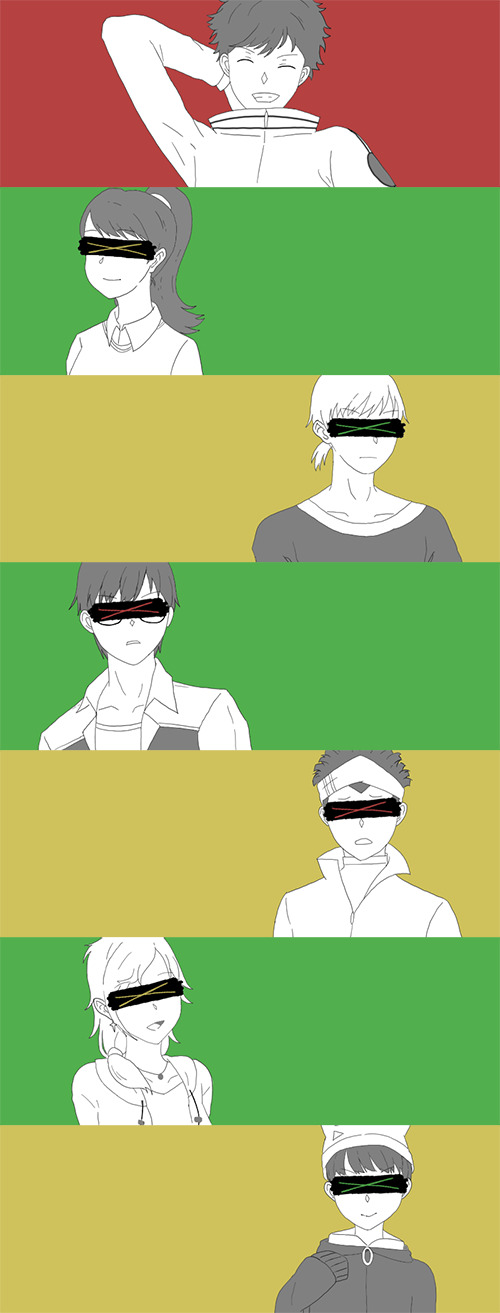
#survive week#digimon survive week#digimon survive#hinata minoru#shibuya aoi#shinonome kaito#kayama shuuji#tominaga ryou#kimishima saki#shinonome miu
22 notes
·
View notes
Text
i am scared for my life
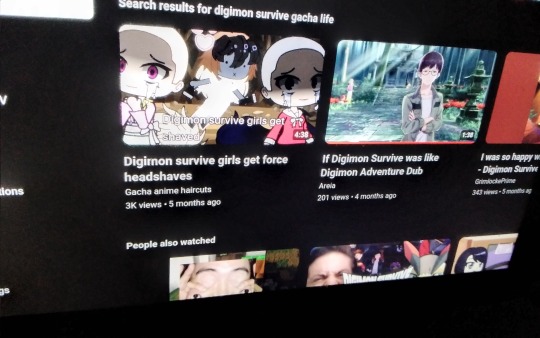
Reblog for larger poll size
Im genuinly scared tho
#digimon#digimon survive#saki kimishima#aoi shibuya#shibuya aoi#kimishima saki#shuuji kayama#kayama shuuji#gacha life#gacha hell#tumblr polls#Polls#tumblr poll
9 notes
·
View notes
Text

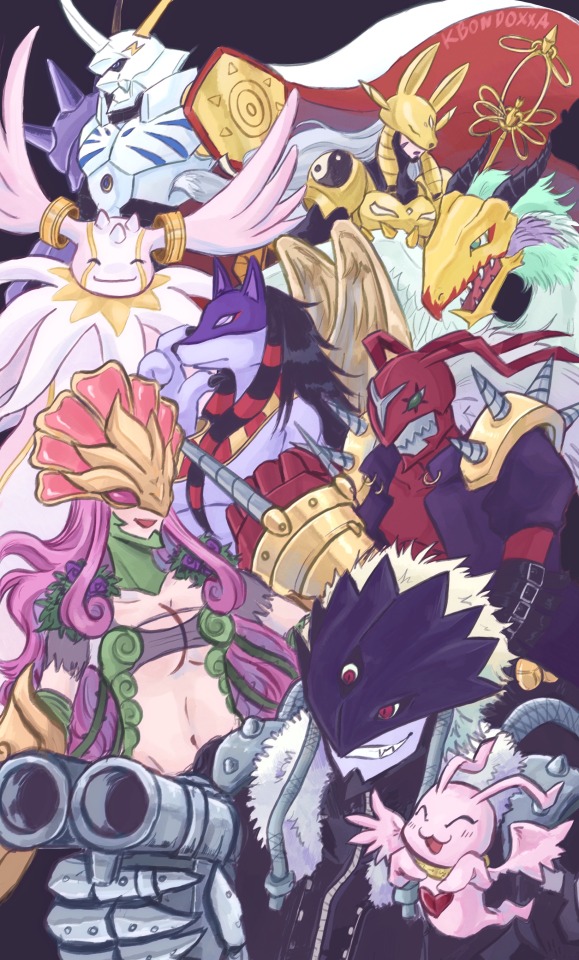
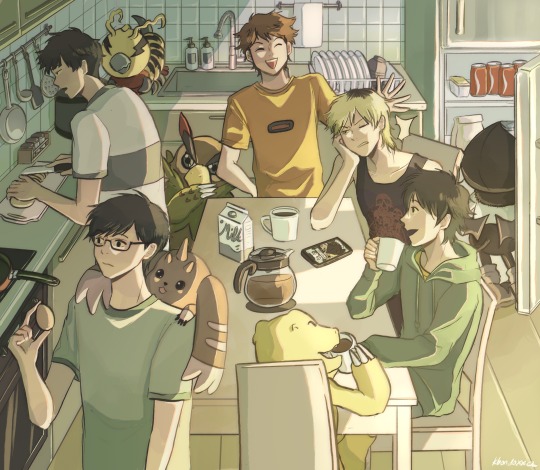

happy 2nd anniversary digimon survive! i’m sorry for no new survive artwork so i reposted my fave survive pieces ive done
#digimon#digimon survive#takuma momozuka#agumon#minoru hinata#falcomon#aoi shibuya#labramon#ryo tominaga#kunemon#saki kimishima#floramon#shuuji kayama#lopmon#kaito shinonome#dracmon#miu shinonome#syakomon
680 notes
·
View notes
Text
Aoi in the Moral route
For day 4 (moral/wrathful/harmony) of @surviveweek, I'll talk about some of the answers for Aoi's character arc the Moral Route and her ultimate evolution scenes provide and how these relate to the larger thematics in the game.
Previously, I wrote at length about how the themes and events in the pre timeline split informed the narrative in Wrathful. If Wrathful is a route about all of the worst extremes in Aoi's rigid thinking and unresolved issues, then what is the game’s answer to these dilemmas? To answer that, we'll recontextualize the themes running through her adult and perfect evolution cutscenes in order to understand the answers provided in Anubimon's.
A desire for Authority.
Outwardly, Aoi's character arc looks quite simple: she's a meek, insecure girl who needs to become more confident. Her evolution cutscenes constantly talk about her desire for power and assertiveness.
In Dobermon’s debut, we can see illustrated the push to get her to take pride in her efforts in order to stand tall in front of adversity:
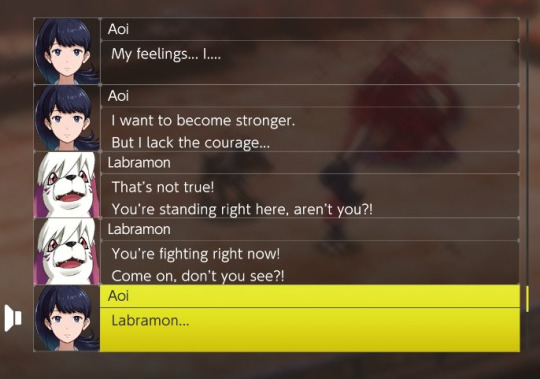
[Image id: Dialogue log.
Aoi: My feelings… I… I want to become stronger. But I lack courage…
Labramon: That’s not true! You’re standing right here, aren’t you?! You’re fighting right now! Come on, don’t you see?!]
And in Cerberumon’s scenario, we see her desire for power laid out in explicit terms:
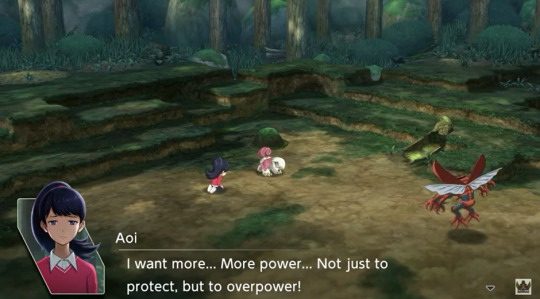
[Image id: Aoi and Labramon chibi models standing in a field, facing off against Kuwagamon. Aoi’s dialogue reads: “I want more… More power… Not just to protect, but to overpower!”]
Aoi: I want more… More power… Not just to protect, but to overpower!
I want to be more than a damsel in distress! I want to defend everyone! And to do that… I need power!
Labramon: (grunting) This feeling, your craving for power. It’s all rushing into me! The strength of your resolve, the courage you use to stand firm… They give me strength!
We can discern that Aoi wants to move on from passively supporting the group to overpowering what threatens them in order for her to protect everyone. It’s not enough for her to simply face things as they come, but she wants to have a more proactive hand when facing whatever comes their way.
In order to fully parse her constant desire for proactiveness, power and confidence, we need to factor in her hidden face shown in Wrathful.
One of the biggest conclusions she comes to in Wrathful is that "She should've been more assertive from the beginning."
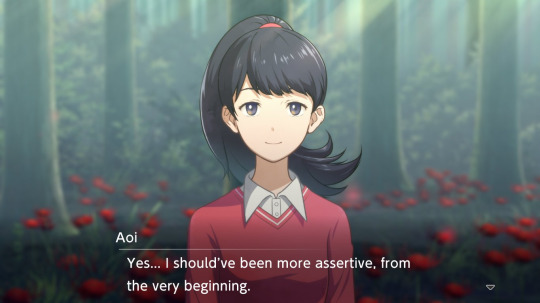
[Image id: Screenshot of Aoi in the spider lily portion of the woods saying “Yes… I should’ve been more assertive, from the very beginning.]
This relates both to her regrets over not being able to guide everyone to proper behavior from the start (let’s remember, she shrinks down the responsibility of leading the group in part two due her own insecurities) and her long-standing resentments stemming from being taken advantage of due her strong sense of responsibility, her desire to be a valuable member in her community and her inability to draw firm boundaries.
The latter is subtly hinted at from the prologue of the game, where she constantly brings up the fact Minoru doesn’t address her appropriately as his senpai in indirect terms. This causes Minoru to keep joking around, which frustrates Aoi deeply and is reflected in the way Labramon harshly chews Minoru out in the early stages of the game.
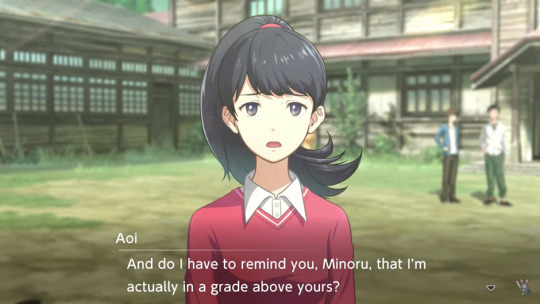


[Images IDs
The first screenshot shows Aoi frowning mildly, saying: “And do I need to remind you, Minoru, that I’m actually in a grade above yours?”
Second and third screenshots show Minoru with a toothy smile, and his dialogue reads: “I mean, shouldn’t you act like it, then, or something? You should be more of a nag, like… “I told you to knock that off!”]
Minoru is joking, but the implication is clear: Aoi lacks the boldness necessary to have any authority over him…
The brief flashback in part 10 reinforces her inability to directly assert herself both due being a pushover and the expectation she ought to make sure the results are satisfactory due her social position; which is also shown in her dialogue as Plutomon before the group fights her a second time:

[Image ID: Plutomon dialogue log that goes as follows:
Plutomon: I hate it when people are selfish, when all they do is complain and put everything on me! Why is it always like this?! So what if I’m class president? Why do only I get lectured? It’s not like I ever wanted to be in charge! I hate dealing with people! I can’t do it! But that’s how it turns out, whether it’s in class, after school, or here! Still, someone has to do the work, and if not me then who? That’s why I do these things!”]
In Wrathful, her response to these struggles is to embrace her desire for aggression unfettered, which translates in her not allowing others to have input in the decisions she takes over everyone's fates, and shutting down any attempt to question her by brute force.


[Img ids: Screenshots of Plutomon, whose dialogue reads: “I can save the world. I can fix it. I can bring peace and harmony with my rule. Humans, monsters… all are to become one with me and share my feelings.]
From these corrupt answers, it's clear that her desire for power encompasses a desire to exert the authority inherent in the social positions she occupies. Which is made very clear in the way Cerberumon's cutscene is phrased, where's an emphasis over how she'll wield her power over others:




[Image ids: screenshots of Aoi and Cerberumon’s chibi models standing in a field, highlighting their dialogue, which goes as follows:
A: Well, a little… But it’s not your body that scares me… It’s the sharp, monstrous shape of the power I craved. Can I truly master such power…?
Cerberumon: Don’t be afraid. As long as your heart is true, even great power will not go astray.]
Aoi worries over whether she can be fair with the power she desires, which can be contrasted to Kaito’s unadulterated desire to get his hands over any power he can get his hands into:
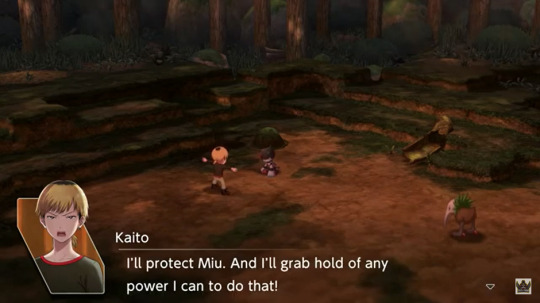

[Image ID: Kaito and Dracmon standing in a field, facing off against Kiwimon. Their dialogue goes as follows:
Kaito: I’ll protect Miu. And I’ll grab hold of any power I can to do that!
Dracmon: Heh, that’s a risky way of thinking. Still, I like your spirit!]
The key difference between the power Aoi and Kaito desire being the scope of it: Aoi wants to proactively look after everyone (the responsibility she has to her community), whereas Kaito only seeks to protect his family and be able to live on his own terms (and as long his desire doesn’t become corrupted into a revengeful spite against the World, these self-centered motivations aren’t necessarily wrong). Thus, Aoi’s worries over being fair with the power she wields.
Still, Cerberumon encourages her to assume her position of authority (to not to be afraid to use such power), and it’s a theme that’s already present from Dobermon's cutscene:

[Image ID: Conversation log between Aoi and Dobermon.
Dobermon: This is how strong your feelings are, Aoi! That’s what gave me this power. I’m proof of your strength. With a just heart, you can wield great power.
Aoi: Labramon…
Dobermon: Now then… Time to teach you some manners. Oh, and Aoi… I’m not Labramon anymore… Call me Dobermon.]
Now that we have established the significance the concepts of Power and Assertivity can encompass for her, we can contrast the way they're applied for Anubimon and Plutomon, respectively.
Anubimon and Plutomon.
One of the biggest differences between the resolve she has with Anubimon and her Plutomon’s ethos is that she explicitly declares she doesn't need any more power despite still holding true her resolve to look after everyone and get them home; instead declaring what she wants is A heart of Justice (the fact they're supposed to be struggling to fend off against the kenzoku in this scenario should Clue you In that Power here doesn't really mean the magnitude of special or physical damage).


[Image IDS: Screenshots to Aoi’s dialogue during Anubimon’s cutscene. It reads: “No (we can’t turn back), we have to hold them off here! Otherwise the others will be in danger! Running won’t solve anything! I refuse to lose anyone! We are all going back home!”]
The theme of a Just Heart is a constant through Labramon’s previous evolutive stages, and, as we’ve seen, it refers to wielding authority fairly. That she doesn’t desire to be more “assertive” clues us in that she no longer feels disrespected nor unable to express her limits and is able to delegate work fairly (to herself and others). This is further supported by the shadow event in Moral’s part 12:
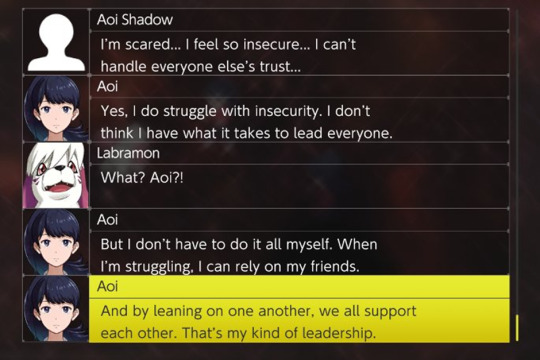
[Image ID: conversation log between Aoi, her shadow and Labramon.
Shadow: I’m scared... I feel so insecure... I can’t handle everyone else’s trust...
Aoi: Yes, I do struggle with insecurity. I don’t think I have what it takes to lead everyone.
Labramon: What? Aoi?!
Aoi: But I don’t have to do it all myself. When I’m struggling, I can rely on my friends. And by leaning on one another, we all support each other. That’s my kind of leadership.]
That she can trust other people to act responsibly and share her burdens leads her to no longer desire to become bolder in order to be respected and stand by her resolve. “Relying on her friends” also translates to her being able to willing share her worries and misgivings, as seen in Anubimon’s cutscene, where she’s able to share her fear over losing the school as their base to the kenzoku:

[Img id: Aoi looking troubled in the forest. Her dialogue reads: I could tell both of you my honest feelings here. But now...]
Of special note is that her mindset here is markedly not self-centered. She uses this painful experience to empathize over how Jijimon and the digimon at the park must have felt over losing their home to the same menace the campers are faced with. This stands in direct opposition to Wrathful not just because of the obvious (that she’s opening up), but because it’s lacking the self-aggrandizing aspect her guilt and self-loathing give to her pain in Wrathful— where she develops an intense tunnel vision where she can’t consider the others might be burdened by Saki’s death as well—after all, they all have already decided that they must keep on moving, roused by Takuma.
Despite her collectivist ideals, Aoi actually has to be reminded to consider how the others are feeling when she’s ruminating over their problems, as seen in this affinity dialogue from part 6:
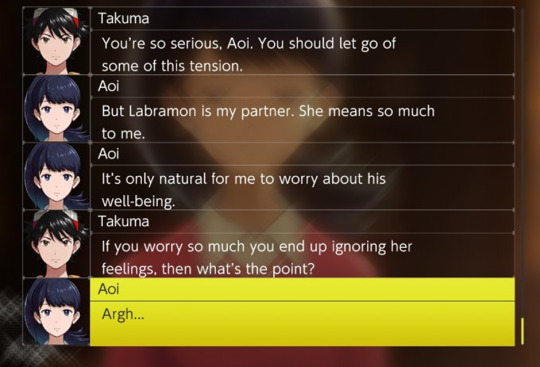
[Image ID: Conversation log between Aoi and Takuma, that reads:
Takuma: You’re so serious, Aoi. You should let go of some of this tension.
Aoi: But Labramon is my partner. She means so much to me. It’s only natural for me to worry about her well-being.
Takuma: If you worry so much you end up ignoring her feelings, then what’s the point?
Aoi: Argh…]
Despite her worry stemming over desire to do right by Labramon, she has the tendency to only consider her perspective and values as the only correct ones to reach a solution, a behavior we see at its worst during her Wrathful spiraling, where she fixates over the mistakes the others made and the need for her to prevent them from being made at all:


[Screenshots of Aoi in the spider lily forest. Her dialogue reads “I wasn’t wrong… Harmony and cooperation ARE the most important things! If everyone felt the same as me, there’d be no more fighting… No more death.]
Needing help is okay.
The humility to acknowledge her own limits, share her burdens with others and consider perspectives outside her own are what facilitate her to a fair leader who, instead of seeking to impose her judgment, guides the group to unanimous consensus (much like Anubimon is a fair judge of the Underworld) and also facilitates her healthier growth in Moral:

[Image ID: Aoi dialogue that reads: “But when people are in trouble, I still want to help! And my friends are counting on me!”]
Instead of her responsibilities to the group being solely imposed on her due her social position (As the remaining oldest kid in Moral, but this also applies to Truthful), they also correspond to her desire to help those in need and doing right by others. Her desire for Justice.

[Image ID: Aoi dialogue that reads “My friends count on me because they believe in me! That gives me all the courage I need!]
This also gives her a sense of purpose and connection to others, something she was struggling with in earlier stages of the game (seen in one of the affinity dialogues where she wonders just what is she to the group and laments being seen just as the Class President everyone can foister their work upon). When she’s able to trust others to pull their weight, the pressure over having to be responsible for the others doesn’t overwhelm her nor feeds her hidden resentments.
Compared to her Plutomon extremism, it’s a down-to-earth approach to dealing with her self-doubt. Being more confident and assertive is what she desires through most of the game, but part of what is stunting her growth is her reticence to open up and rely on others; this is something she has to constantly be reminded to take care of by Labramon, Takuma and Saki. Over time, her own limitations and fears stop being something selfish she imposes over others. The worry over making the wrong decision and letting everyone down or bringing in terrible consequences is still present, but she’s able to accept these struggles without them being world-ending because she has the support she needs. Just like Nott put it in their Ryo-Shuuji write-up, being able not to dwell in one’s mistakes is a key component for this group to be able to move forward and do better. It doesn’t have to be damming if the pressure is too high or the work too much because she can count on the others. This speaks to Survive’s ideal for shared responsibility both for communal problems but also personal growth.
#digimon survive#digimon survive spoilers#long post#survive week#day 4: vanilla routes#Aoi Shibuya#Shibuya Aoi#Wrahtful Route#Moral Route#digisafe#uh what else i think this is all the tags i need#meta#mine#Aoi
29 notes
·
View notes